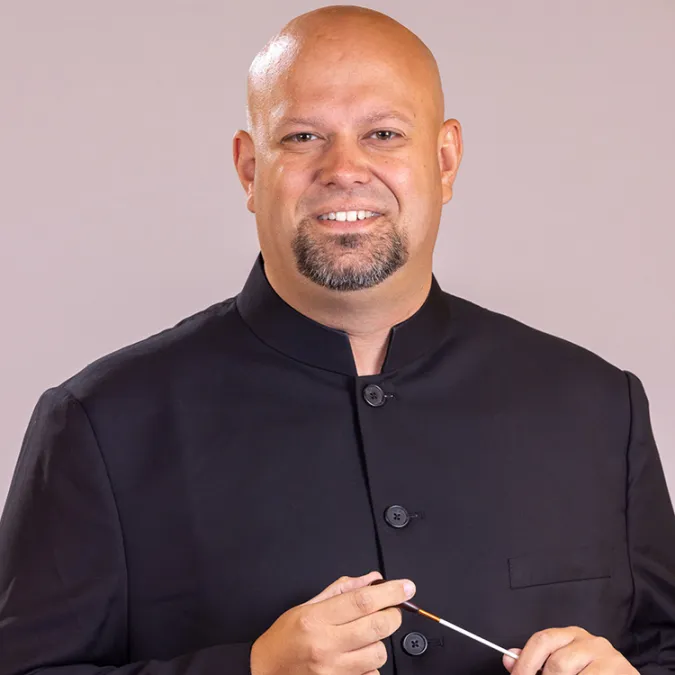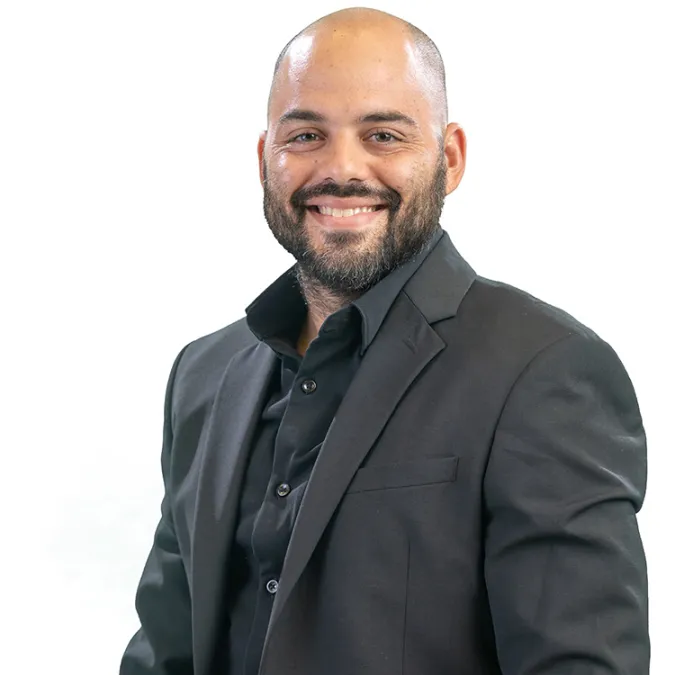
Drew Dickey, conductor
Douglas Henderson, conductor
Jimmy Santos-Rivera, guest conductor
Page Stephens, soprano
This concert will last about 90 minutes with one intermission.
Please silence your electronic devices.
Photography, video, or recording of any part of this performance is prohibited
Program
Symphony Band
Frank Ticheli
Angels in the Architecture
Page Stephens, soprano
traditional
arr. Omar Thomas
Shenandoah
David Maslanka
Give Us This Day
Moderately Slow
Very Fast
intermission
Wind Symphony
Omar Thomas
A Mother of A Revolution!
Jimmy Santos-Rivera, conductor
Modest Mussorgsky
trans. Patterson
Pictures at an Exhibition
Promenade
Gnomus
Promenade
The Old Castle
Promenade
Tuileries
Bydlo
Promenade
Ballet of the Chicks in Their Shells
Samuel Goldenberg and Schmuÿle
Limoges
Catacombs
Cum mortuis in lingua mortua
The Hut on Fowl's Legs
The Great Gate of Kiev
About the Program
Frank Ticheli
Angels in the Architecture
Born January 21, 1958 Monroe, LA
Composed 2008
Premiered July 6, 2008, Matthew George, conductor, Sydney Opera House
Duration 15 minutes
The work unfolds as a dramatic conflict between the two extremes of human existence—one divine, the other evil. The work’s title is inspired by the Sydney Opera House itself, with its halo-shaped acoustical ornaments hanging directly above the performance stage.
Angels in the Architecture begins with a single voice singing a 19th-century Shaker song:
I am an angel of Light
I have soared from above
I am cloth’d with Mother’s love.
I have come, I have come,
To protect my chosen band
And lead them to the promised land.
This “angel”—represented by the singer frames the work, surrounding it with a protective wall of light and establishing the divine. Other representations of light played by instruments rather than sung—include a traditional Hebrew song of peace (“Hevenu Shalom Aleicham”) and the well-known 16th-century Genevan Psalter tune “Old Hundredth.” These three borrowed songs, despite their varied religious origins, are meant to transcend any one religion, representing the more universal human ideals of peace, hope, and love. An original chorale, appearing twice in the work, represents my own personal expression of these aspirations. In opposition, turbulent, fast-paced music appears as a symbol of darkness, death, and spiritual doubt. Twice during the musical drama, these shadows sneak in almost unnoticeably, slowly obscur- ing, and eventually obliterating the light altogether. The darkness prevails for long stretches of time, but the light always returns, inextinguishable, more powerful than before. The alternation of these opposing forces creates, in effect, a kind of five-part rondo form (light–darkness–light–darkness–light). Just as Charles Ives did more than a century ago, Angels in the Architecture poses the unanswered question of existence. It ends as it began: the angel reappears singing the same comforting words. But deep below, a final shadow reappears—distantly, ominously.
– Frank Tichelli
Omar Thomas
Shenandoah
Born 1984, Brooklyn, N.Y.
Composed 2019
Duration 8 minutes
"Shenandoah" is one of the most well-known and beloved Americana folk songs. Originally a river song detailing the lives and journeys of fur traders canoeing down the Missouri River, the symbolism of this culturally-significant melody has been expanded to include its geographic namesake—an area of the eastern United States that encompasses West Virginia and a good portion of the western part of Virginia—and various parks, rivers, counties, and academic institutions found within. Back in May of 2018, after hearing a really lovely duo arrangement of "Shenandoah" while adjudicating a music competition in Minneapolis, I asked myself, after hearing so many versions of this iconic and historic song, how would I set it differently? I thought about it and thought about it and thought about it, and before I realized it, I had composed and assembled just about all of this arrangement in my head by assigning bass notes to the melody and filling in the harmony in my head afterwards. I would intermittently check myself on the piano to make sure what I was imagining worked, and ended up changing almost nothing at all from what I’d heard in my mind’s ear. This arrangement recalls the beauty of Shenandoah Valley, not bathed in golden sunlight, but blanketed by low-hanging clouds and experiencing intermittent periods of heavy rainfall (created with a combination of percussion textures, generated both on instruments and from the body). There are a few musical moments where the sun attempts to pierce through the clouds, but ultimately the rains win out. This arrangement is at times mysterious, somewhat ominous, constantly introspective, and deeply soulful.
– Omar Thomas
David Maslanka
Give Is This Day
Born August 30, 1943, New Bedford, Massachusetts
Died August 7, 2017
Composed 2006
Premiered February 17, 2006, Rancho Buena Vista High School Wind Ensemble, Eric Weirather, conductor, 2006 California Band Directors Association convention
Duration 15 minutes
The words “Give us this day” are, of course, from the Lord’s Prayer, but the inspiration for this music is Buddhist. I have recently read a book by the Vietnamese Bhuddist monk Thich Nhat Hahn (pronounced “Tick Nat Hahn”) entitled For a Future to be Possible. His premise is that a future for the planet is only possible if individuals become deeply mindful of themselves, deeply connected to who they really are. While this is not a new idea, and something that is an ongoing struggle for everyone, in my estimation it is the issue for world peace. For me, writing music, and working with people to perform music, are two of those points of deep mindfulness. Music makes the connection to reality, and by reality I mean a true awakeness and awareness. Give Us This Day gives us this very moment of awakeness and awareness so that we can build a future in the face of a most dangerous and difficult time. I chose the subtitle, “Short Symphony for Wind Ensemble,” because the music is not programmatic in nature. It has a full-blown symphonic character, even though there are only two movements. The music of the slower first movement is deeply searching, while that of the highly energized second movement is at times both joyful and sternly sober. The piece ends with a modal setting of the choral melody “Vater Unser in Himmelreich” (Our Father in Heaven) – No. 110 from the 371 four-part chorales by Johann Sebastian Bach.
– David Maslanka
Omar Thomas
A Mother of a Revolution
Composed 2019 , Commissioned by the Desert Winds Freedom Band for the 50th anniversary of the Stonewall uprising
Duration 4 minutes
This piece is a celebration of the bravery of trans women, and in particular, Marsha "Pay It No Mind" Johnson. Marsha is credited with being one of the instigators of the famous Stonewall uprising of June 28, 1969—one of the pivotal events of the LGBTQ liberation movement of the 20th century—which is commemorated annually during the worldwide Gay Pride celebrations. Existing as a trans woman, especially a trans woman of color, and daring to live authentically, creating space for oneself in a transphobic world is one of the bravest acts I can imagine. Over 20 trans women were murdered in the United States in 2018 alone. There is no demographic more deserving, and frankly, long overdue for highlighted heroism and bravery. The disco vibe in the latter half of the piece is meant to honor club culture, a sacred space held amongst LGBTQ persons in which to love, live, mourn, heal, strategize, connect, disconnect, and dance in defiance of those outside forces who would seek to do LGBTQ persons harm simply for daring to exist and take up space. We pump our fists to honor the life, heroism, activism, and bravery of Marsha P. Johnson, to honor the legacy of the Stonewall revolution, to honor the memory of the trans lives violently ended due to fear and hatred, and in honor of trans women worldwide who continue to exist unapologetically and who demand to be seen.
– Omar Thomas
Modest Mussorgsky
Pictures at at Exhibition
Born March 21, 1839, Karevo, Russia
Died March 28, 1881, Saint Petersburg, Russia
Composed June 1874
Published 1886
Duration 35 minutes
Modest Mussorgsky met the architect and painter Viktor Hartmann in 1866 through their mutual friend, the critic Vladimir Stasov. The two became fast friends and mutual admirers of the other’s art, with Mussorgsky dedicating a song to Hartmann, and Hartmann gifting the composer two paintings. In 1973, the 34 year-old Hartmann died suddenly of an aneurysm, leaving an entire community of Russian artists to grieve the loss, including Mussorgsky. Six months later, Stasov organized a memorial exhibition of over 400 Hartmann works in the Imperial Academy of Arts in Saint Petersburg. Mussorgsky visited the exhibit (which included the two paintings from his own collection), and was struck with a rare moment of compositional clarity. The untrained composer who was often plagued with self-doubt and self-sabotaging behaviors, worked feverishly on a new work based on the exhibit. He wrote to Vladimir Stasov saying: “Ideas, melodies, come to me of their own accord. Like roast pigeons in the story, I gorge and gorge and overeat myself. I can hardly manage to put it all down on paper fast enough.”
What resulted was a musical walking tour through the Hartmann exhibit, which Mussogsky was wildly pleased with, and which his colleagues could not understand. As Golenishchev-Kutuzo recounted: “In music for these illustrations, as Mussorgsky called them, he represented [chicks], children, Baba Yaga in her wooden house on chicken legs, catacombs, gates, and even rattling carts. All this was not done jokingly, but 'seriously.' There was no end to the enthusiasm shown by his devotees; but many of Mussorgsky's friends, on the other hand, and especially the comrade composers, were seriously puzzled and, listening to the 'novelty,' shook their heads in bewilderment.” Originally conceived as a virtuosic work for solo piano, the work wasn’t published until years after his death, and is now most-often heard in its posthumous orchestrations and transcriptions for orchestras and wind bands.
The iconic opening Promenade, with its asymmetry and modal meanderings, gives the impression of Mussorgsky “roving through the exhibition, now leisurely, now briskly in order to come close to a picture that had attracted his attention, and at times sadly, thinking of his departed friend.” It is reprised several times, in unique iterations as he explores the gallery.
Gnomus: according to Stasov, “a child’s plaything, fashioned, after Hartmann’s design in wood, for the Christmas tree at the Artists’ Club...It is something in the style of the fabled Nutcracker, the nuts being inserted into the gnome’s mouth. The gnome accompanies his droll movements with savage shrieks.”
Il vecchio castello (The Old Castle): an Italian castle stands isolated, and a troubadour (English horn) sings a lament.
Tulleries: a Parisian park with quarrelling kids, and doting nannies.
Bydło (Polish Oxcart):a Polish peasant is pushing an old cart with heavy yet reliable wheels.
Ballet of the Unhatched Chicks: ballet dancers in eggshell costumes: adorable.
Samuel Goldenberg and Schmuÿle: Mussorgsky’s two Hartmann paintings were two portraits of Jewish men. They were unnamed in the paintings, but Stasov named them Goldenberg and Schmuyle.
The Market at Limoges: the hustle and bustle as a woman explores a French city market.
Catacombs: Mussorgsky wrote “The creative spirit of the dead Hartmann leads me towards skulls, apostrophizes them—the skulls are illuminated gently from within.”
The Hut on Chicken Legs (Baba Yaga): the witch Baba Yaga lives in a hut built on chicken legs. Like all witches, flies through the air.
The Great Gate of Kyiv: Hartmann’s vision for new gates into the city: stone replacing wood, an imperial eagle atop, and a three story belfry. The musical depiction is grand and distinctly Russian. Although Hartmann’s renderings were never realized, their majesty is palpable.
– Mark Bilyeu
About the Artists
Page Stephens

Page Stephens is a mezzo soprano, voice teacher and arts administrator based in Austin, TX with a soft spot for new music. She is a founding member of VAMP, an all-female vocal quintet which champions music by women and living composers. VAMP's debut album will be released in Spring 2025. Stephens has premiered works by Reena Esmail, Matthew Lyons, Donald Grantham, Katherine Pukinskis, Dana Lyn, Russell Podgorsek, Thomas B. Yee, and others. Stephens maintains a robust performing career in a wide variety of genres. In the last decade, she has performed with Copland House, Voices of Change, River Oaks Chamber Orchestra, Austin Symphony Orchestra, line upon line percussion, Sō Percussion, Texas Early Music Project, invoke string quartet, and many others. In addition to performing, Stephens is on the voice faculty at Austin Community College. She is the assistant director for operations at the Butler School of Music at The University of Texas at Austin, where she also received her master’s and D.M.A. degrees.
Christopher Dickey

Christopher Drew Dickey serves as associate director of the Longhorn Band and as assistant director of bands at the Butler School of Music at The University of Texas at Austin. In addition to his appointment at Texas, Dr. Dickey also serves as the music design coordinator with the Pacific Crest Drum and Bugle Corps in Diamond Bar, California and on the brass instructional staff with The Bluecoats Drum and Bugle Corps in Canton, Ohio. Prior to his current appointments, Dr. Dickey held positions at The South Carolina School of the Arts at Anderson University and Southwood Academy of the Arts, spending a number of years as an educator and administrator in the public schools. He holds the degrees of doctor of musical arts in wind conducting from The University of Texas At Austin, master of music in music education from the Ithaca College School of Music, master of music in wind conducting from Louisiana State University, and bachelor of music in music education from the University of South Carolina
Douglas Henderson

Douglas Henderson serves as associate director of bands at The University of Texas at Austin, where his responsibilities include conducting the Wind Symphony, teaching advanced undergraduate and graduate conducting, and teaching band literature. Prior to joining the UT faculty, Dr. Henderson was an associate professor, associate director of bands, and director of athletic bands at Oklahoma State University. Dr. Henderson is active as a guest conductor, adjudicator, and clinician throughout the United States, and he has guest conducted in Austria and Japan. He is a frequent guest conductor of the World Youth Wind Orchestra Project (WYWOP), in Schladming, Austria. Dr. Henderson received his bachelor of music degree in music studies from The University of Texas at Austin, his master of music degree in wind conducting from Michigan State University, and his doctor of musical arts degree in wind conducting from The University of Texas at Austin. From 2003-2006, he was the associate director of bands at J.J. Pearce High School in Richardson, Texas.
Jimmy Santos-Rivera

Jimmy Santos-Rivera (he/him) is currently pursuing a master of music in wind conducting at The University of Texas at Austin, where he serves as a graduate teaching assistant. In this role, he assists in conducting and managing the university’s concert bands, athletic bands, and conducting courses. He earned his bachelor of arts in music education, with a minor in percussion, from the University of Puerto Rico, Río Piedras. Born and raised in Puerto Rico, his career has been deeply rooted on the island. Prior to moving to Austin, Santos-Rivera spent eight years teaching concert band, percussion, and music theory at Escuela Especializada en Bellas Artes Pablo Casals. As a performer, he has played in the percussion section of the Puerto Rico Symphony Orchestra, the Puerto Rico Wind Symphony, and the Puerto Rico Philharmonic Orchestra. In 2019, he joined the 248th Army Band in San Juan, Puerto Rico, where he currently serves as a percussionist in various ensembles and as the principal conductor of the concert band. His mentors include Carlos Ávila, Eddy Marcano, Karlo Flores, and Carmen Acevedo.
Symphony Band
Flute
Micah Bronaugh
Hailey Hickerson
Juan Fajardo
Gerardo Ayala
Josey April
Natalie Porter
Sadie Bridge
Ramexes Lamboloto
Rabeeba Mahaseen
Oboe
Emma Ball
Kevin Xiong
Tara Tran-Huu
Luke Sanchez
Noah O'Brien
Reagan Tompkins
Clarinet
Aidan Mcneese
Charlotte Juneau
Emelie Wu
Georgia Castillo
Annabelle Fontanilla
Fiona Condron
Ceye Bridges
Bassoon
Gabriella Jensen
Judith Salas
Carson McCay
Darren Tea
Saxophone
Chantal Lee
Luc Billette
Jackson Byrd
Ben Crowley
Thomas Nuttall
Brandon Shen
Sasha Sanchez
Diego Cruz
Joseph Lowry
Pablo Ramon III
Phoenix Alcera
Daniel Kim
Nigel Duplessis
Horn
Bianca Miller
Ellie Howard
Luke Onorato
Ashley Young
Ben Roberts
Trumpet
Matthew Nichols
Arianna Shepherd
Jaime Hernandez
Scout Howard
Trombone
Hunter Irwin
Jackson Hawk
Jan Campos
Troy Teggatz
Joshua Gault
Ryan Smalley
Euphonium
Eric Ingram
Casey Hawthorne
Tuba
Olga Tumanova
Daniel LeCompte
Samantha Yanez
Drake Boff
Antonio Musgrove
Andrew Bearse
Percussion
Khaden Joyner
Federico Lopez
Zakary King
Victoria Garcia
Joel Rodriguez
Cedrick Clark
Harp
Willow Goldsmith
Keyboard
Shao Chu Pan
String Bass
Reilly Curren
Wind Symphony
Flute
Jane Anderson
Diego Arias
Maggie Chvatal
Koustubh Galagali
Mercedes Gomez
Nichole Thompson
Ai Ni Wu
Oboe
Sarah Bird
Mary Creel
Lademi Davies
Spencer Dwyer
Clarinet
Madison Bookman
Brynn Carl
Natalie Eddings
Michael Golston
Darien Salter
Samuel Shin
Aldo Villanueva
Alex Vo
Bassoon
AB Brown
Naomi Kitamura
Gavin Malden
Sabrina Pector
Saxophone
Quinlan Collins
Lucy Croasdale
Austin Davidson
Jacob Otchis
Levi Peña
Inbo Shim
Sam Stricklin
Horn
Maggie Euscher
Dylan Marquez
Ian Welch
Elizabeth Whitehead
Trumpet
Adam Dimas
Dash Kostka
Kristopher Montemayor, Jr.
Anthony Ramirez
JT Wolf
Trombone
Erick Galicia
Landon Reimer
Benjamin Valliere
Luis Cadena, bass
Jackson Quevedo, bass
Euphonium
Nicolas Love
Andrew Shaffer
Tuba
Grant Fenstad
Chancellor Joseph
Percussion
Aaryn Avila
Spencer Frismanis
Randy Griner
Ashley Hsu
Erica Lin
Harp
Alyssa Vought
Celeste
Shuyi Xie
Double Bass
Reilly Curren
Upcoming Events

Wind Ensemble
Celebrating THE CENTENNIAL OF GUNTHER SCHULLER’S BIRTH
Jerry Junkin, conductor
Hector Berlioz, arr. Schuller
Overture to Le Corsaire
Scott Joplin, ed. Schuller
Combination March
Gunther Schuller
Meditation
Symphony No. 3, In Praise of Winds
Friday, February 28, 7:30 pm
Bates Recital Hall
Wind Symphony
Wednesday, March 26, 7:30 pm
Bates Recital Hall
Free Admission
Symphony Band
Monday, March 31, 7:30 pm
Bates Recital Hall
Free Admission
Wind Ensemble
Featuring Caleb Hudson, trumpet
Friday, April 11, 7:30 pm
Bates Recital Hall
Wind Symphony
Wednesday, April 23, 7:30 pm
Bates Recital Hall
Free Admission
Symphony Band
Sunday, April 27, 7:30 pm
Bates Recital Hall
Free Admission
Event Details
Free admission

